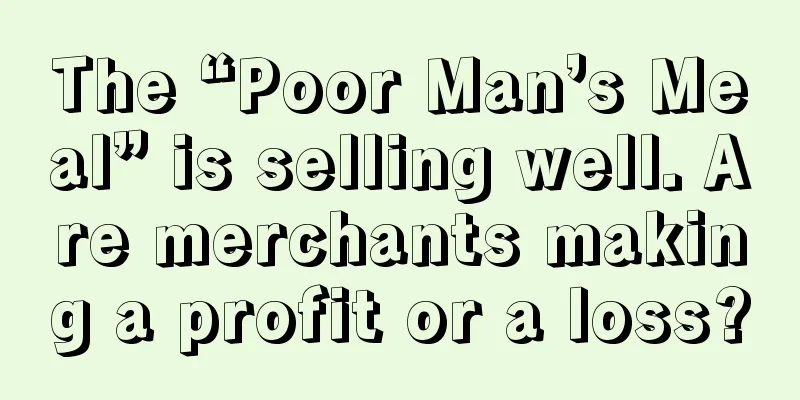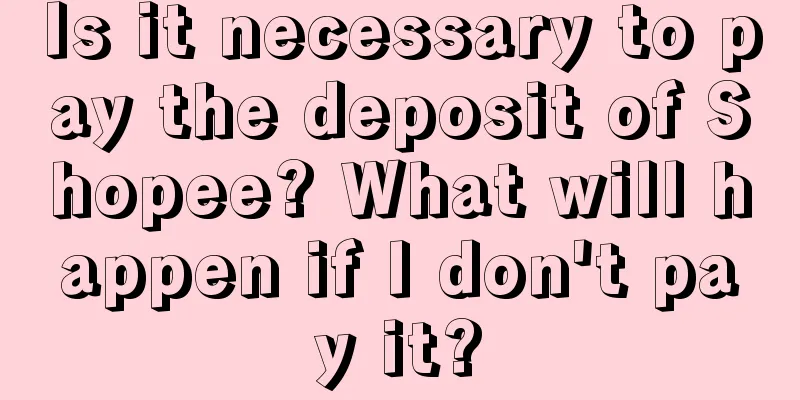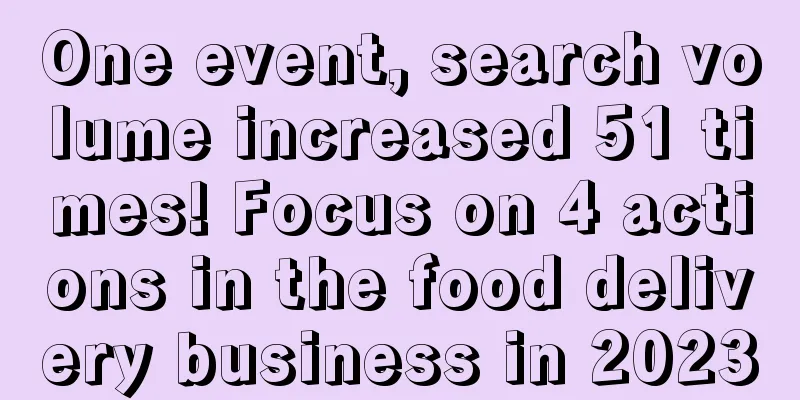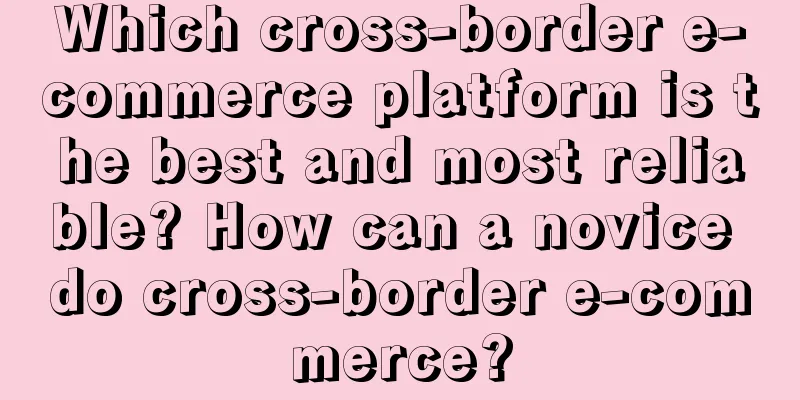The “Poor Man’s Meal” is selling well. Are merchants making a profit or a loss?

In the past two years, the trend of "poor guy packages" has become more and more intense. From McDonald's "1+1" free combination, KFC's "Crazy Thursday", Luckin Coffee and Coodi's 9.9 yuan coffee, to Nanchengxiang's 3 yuan buffet breakfast and 19.9 yuan hot pot set meal, more and more brands have begun to launch low-priced sets. Even Sam's Club, which is regarded as a Chinese food configuration, has become a hot search with its "poor man's three-piece set" and is sought after by many netizens. In fact, it is not new for brands to launch "poor man's packages". Long before the rise of catering group buying, there were many examples of using low-priced products to "attract customers" in the market, such as Waipojia's 3 yuan mapo tofu, IKEA's 1 yuan ice cream, etc., which are all the subjects of everyone's talk. However, looking at the current market, brands launching low-priced packages are no longer an exception. Everyone is rushing to join this marketing market that seems to conform to the market but is actually full of controversy. So, why can the "poor man's meal" enter the hearts of young people? Why can it become a breakthrough for businesses to explore growth? How can we become the final winner in this "battle"? Let's talk about it today. 1. Young people in the “stingy economy” establish a new consumption consensusIf we take stock of the key words in the market over the past two years, we cannot escape the word "low price". From the opening of more and more stores of Haotemai and Hitego, the launch of "Mountain Moving Price" by Hema Fresh, the affordable old domestic products that have been on the hot search list one after another, to Pinduoduo, whose market value once exceeded that of Alibaba, everyone seems to want to use "low price" to break through the difficulties. But are consumers really poor? Actually, it is not. We can only say that everyone's "consensus on consumption" has changed. In an era of rapid growth, many people will use product premiums to show their identity and reflect their economic strength. Just like the Veblen effect mentioned: when the price of a commodity increases, it is more likely to attract consumers' attention and make them pay for it. Moreover, this is not an individual or local cognition. Even consumers who do not buy high-premium products will have a consumer consensus that "buying high-premium products = having economic strength." It's just that in the current market environment, more and more people are beginning to choose rational consumption. Of course, rational consumption does not mean consumption downgrade, and "stingy economy" does not mean giving up all good and exquisite things. Everyone has a new scale in their hearts: when buying things, they no longer buy for the purpose of showing off or displaying, but pay more attention to the use value of the goods. And when this trend becomes a consumer consensus, people will not reduce their sense of happiness because of "saving money". Xiaohongshu's data tool "Xinhong" shows that the average daily number of likes for the "poor ghost package" notes on Xiaohongshu in the second half of last year was 2,366 times, and the average daily number of likes from the beginning of 2024 to mid-March reached 5,799 times. So far, the topic #Poor Ghost Package# on Douyin has been played more than 800 million times, and the themes of inventory and store exploration are very popular. Simply put, looking for "poor ghost packages", trying "poor ghost packages" and sharing "poor ghost packages" have become a popular trend. 2. The external environment is changing, and businesses also need to actively save themselvesIn addition to the iteration of consumer consensus, changes in the external environment are also the fundamental reason why merchants launched the "poor man's package". Even though most of the "poor man's package" is not profitable, it is undeniable that it has won market and traffic for brands and merchants. After all, at a time when the market is gradually saturated and competitors are beginning to roll back, the path to growth can easily go back to the starting point, and any breakthrough in the gap is critical. First, adapt to consumption trends and keep the brand active in the market. The consumption characteristics of the "M-shaped society" proposed by Japanese scholar Kenichi Ohmae, the two vertical lines of the letter M represent the expansion of the "extremely wealthy" and "poor class", while the V-shaped line in the middle represents the decline of the middle class. In such an economic context, everyone is looking for products with better cost-effectiveness and quality-price ratio. The previous strategy of increasing profits by raising product prices is no longer feasible. The low-price strategy can keep the brand alive in the competition and maintain market share and competitiveness. Brands and merchants can also use low-cost options to attract new customers who are price-sensitive or have limited budgets, while maintaining stability and playing the role of "attracting new customers". Secondly, the communication environment is put in place in advance to stimulate consumers' non-immediate needs. In the past, most people first had a dining need, then started to choose categories and stores, and finally chose specific dishes. Each link was an immediate need of consumers. After the brand's "poor ghost meal" has gained a certain degree of popularity, it can also stimulate consumers' non-immediate needs - even if they don't have the idea of eating now, and haven't decided whether to eat, they will have the motivation to go to this store in their minds, which greatly increases the probability of being selected. 3. The prevalence of “poor man’s packages” may cause both businesses and consumers to “lose”On the surface, the increasingly popular "poor man's package" can make consumers and merchants win-win: consumers can enjoy more cost-effective products at lower prices, and merchants can take this opportunity to maintain market vitality and attract more new customers. But in fact, many brands' "poor man's package" not only failed to bring them growth, but also created a "lose-lose" situation. On the one hand, many ultra-low-priced meal packages have no profit at all. If merchants choose to "cut costs" on product costs and continuously reduce product quality, it will damage the brand's early accumulated food stories, product design, and the brand trust accumulated over the years. If consumers do not have a good experience from the "poor man's meal package", the merchant will not only fail to make money, but also affect its original reputation. On the other hand, normalized low prices will affect the regular-price customer base that has been cultivated over a long period of time. Early group purchases were very restrained, with relatively strict thresholds and rules. For example, a certain price would take effect only if a certain sales threshold was reached within a certain period of time. And there are tricks behind these numbers. Merchants will calculate how many copies to sell in a unit of time and how much each copy should be sold for to be more cost-effective, focusing on a strategy of small profits but quick turnover. However, the "poor guy's meal" launched by many brands now is more like a kind of involution. The conventional low-price strategy makes old customers who used to buy at regular prices feel uncomfortable, and it is difficult for the dishes that have been painstakingly created to return to regular price sales. 4. Final ThoughtsThe "poor man's meal" is a double-edged sword. In the context of continuous iteration, it gives consumers a new choice and also gives brands an opportunity to seek growth. However, there are not many cases like McDonald's 1+1 and KFC Crazy Four that can continue to do so and make money without losing money. Putting aside the ideas of healthy competition and long-term strategy, if you want to make the "poor man's meal" a growth tool, you still have to pay attention to the following three points. First of all, "poor ghost" is a self-deprecating and teasing term, so it is best not to use it as a key word for promotion. Secondly, do not focus all your attention on the price involution with competitors, and do not lower the quality of the "poor ghost package". Finally, it is necessary to clarify one's own interim and ultimate goals, rather than relying solely on low prices to grab traffic and not turning traffic into retention. In short, the "poor ghost package" is indeed a good solution, but how to have both volume and reputation requires "planning before action". Author: Mr. Bingfa Source: Marketing Strategy "(ID: lanhaiyingxiao)" |
<<: 800,000 people watched Wahaha’s drastic changes and gave thousands of opinions!
>>: After this update of Station B, movie commentators can no longer bear it
Recommend
After analyzing 800 popular articles, I discovered the gameplay of the explosive content in the wine category of Xiaohongshu!
How can tipsy low-alcohol wines stand out on the X...
Has LV fallen from grace in the yoga world? In a polarized consumer market, is “low price” the only rule?
Inventory surged, stock prices fell, profits fell ...
Taobao 88VIP major upgrade, will it compete head-on with JD.com PLUS members?
As paying members, who is better this year? Every ...
Museums "come down to earth" to make money, and tourism "special forces" can't handle it anymore
For museums, becoming internet celebrities is a tr...
5 Trends of Creative Packaging in 2023
Creative packaging can enhance the brand image of ...
Taobao is finally willing to save its web version
Recently, the news that everyone is concerned abou...
Celebrities take part, brands increase their investment, who is profiting behind the hot “explosive reform” trend?
From ordinary people to celebrities, the trend of ...
How to ship goods when opening a cross-border e-commerce store on Amazon?
With the development of the Internet, the cross-bo...
Another Xin Jifei? "Food profiteer" reveals industry insider information, gains millions of followers in a week
Recently, two dark horse accounts have appeared in...
This is the most complete guide to sorting out the data indicator system!
The data indicator system is an important tool for...
Xiaohongshu is easy to defend but difficult to attack
It is reported that Xiaohongshu has completed a ne...
What does Amazon A+ content mean? What are its uses?
As for Amazon A+ page, it is the first time for ne...
DHgate.com launches new product growth center
In order to enhance the buyer experience, increase...
Amazon takes on Temu and SHEIN
As a global e-commerce giant, Amazon has recently ...
After creating 1,000 communities, we summarized 6 steps to activate “dead” private groups!
How to activate a private domain "dead" ...









